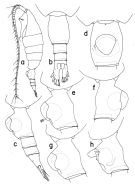|
|
 |
|
Calanoida ( Order ) |
|
|
|
Arietelloidea ( Superfamily ) |
|
|
|
Heterorhabdidae ( Family ) |
|
|
|
Heterorhabdus ( Genus ) |
|
|
| |
Heterorhabdus tuberculus Park, 2000 (F,M) | |
| | | | | | | Ref.: | | | Park, 2000 (p.122, figs.F,M, Rem.) |  issued from : T. Park in Bull. Scripps Inst. Oceanogr. Univ. California, San Diego, 2000, 31. [p.242, Fig.90]. Female: a, habitus (left side); b, c, urosome (dorsal, left, respectively); d, e, f, genital somite (ventral, left, right, respectively); g, genital somite (left, tilted clockwise); h, genital somite with operculum open. gfl = genital flange. Nota: Length ratios of 4 urosomal somites and left caudal ramus 38.9 : 16.5 : 12.9 : 8.2 : 23.5 = 100. Dorsal appendicular seta of left caudal ramus approximately 1.5 times longer than that of right ramus. Anteriorly, each caudal ramus with 2 pores.
|
 issued from : T. Park in Bull. Scripps Inst. Oceanogr. Univ. California, San Diego, 2000, 31. [p.243, Fig.91]. Female: a, genital somite (dorsal); b, genital somite from different specimen (dorsal); c, d, abnormal genital somites (left). Male: e, P5 (anterior); f, P5 (distal segments of rami omitted), anterior.
|
 Heterorhabdus tuberculus Heterorhabdus tuberculus female: 1 - See key to species groups of Heterorhabdus: ''abyssalis'' Group (p.90, 114). 2 - Genital somite without a conical projection mediodorsally (Fig.90- a, c). 3 - Laterally, genital somite without a tubercular outgrowth posteriorly on dorsal margin (Fig.90-c, f). 4 - Laterally, genital operculum far short of reaching posterior end of somite (Fig.90-c). 5 - Laterally, right and left genital flanges asymmetrical (Fig.90-e, f). 6 - Laterally, left genital flange high, like a tubercular outgrowth (Fig.90-e).
|
 Heterorhabdus tuberculus Heterorhabdus tuberculus male: 1 - See key to species groups of Heterorhabdus: ''abyssalis'' Group (p.90, 114). 2 - Basal inner lobe of left P5 short, finger-like (Fig.91-f). 3 - Basal inner lobe of left P5 distally truncate (Fig.91-f).
| | | | | NZ: | 6 | | |
|
Distribution map of Heterorhabdus tuberculus by geographical zones
|
| | | | | | | | | | Loc: | | | Mozambique Channel, NE Indian, Indonesia (Banda Sea), China Seas (East China Sea), Pacif. equatorial (S-N), Pacif. central Est (S-N), off San Diego, off Baja California
Type localities: 17°46'S, 110°19'W & 27°23'N, 116°12'W.
For Park (2000, p.123), this species seems to be an Indo-Pacific, taken in the eastern Pacific between 17°50' S and 38°40' N; in the central Pacific between 04°57' S and 15°00' N, in the Malay Archipelago at 04°40' S, 125°33' E, in the East China Sea at 17°44' N, 119°55' E; in the eastern Indian Ocean at 02°28' S, 86°23' E and in the Mozambique Channel at 25°42" S, 35°28 ' E. | | | | N: | 1 | | | | Lg.: | | | (824) F: 2,84-2,24; M: 2,68-2,24; {F: 2,24-2,84; M: 2,24-2,68} | | | | Rem.: | "Abyssalis" Group.
For Park (2000, p.123) H. prolixus, H. clausi, H. tuberculus are morphologically very close to one another and can be distinguished from one another by carefully comparing the shape of the female genital somite and the male P5. | | | Last update : 20/05/2017 | |
|
|
 Any use of this site for a publication will be mentioned with the following reference : Any use of this site for a publication will be mentioned with the following reference :
Razouls C., Desreumaux N., Kouwenberg J. and de Bovée F., 2005-2025. - Biodiversity of Marine Planktonic Copepods (morphology, geographical distribution and biological data). Sorbonne University, CNRS. Available at http://copepodes.obs-banyuls.fr/en [Accessed August 23, 2025] © copyright 2005-2025 Sorbonne University, CNRS
|
|
 |
 |





